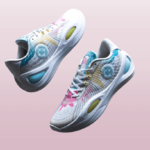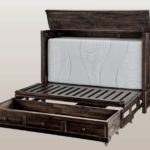Several now-iconic skateboard companies emerged during the industry’s heyday in the 1990s. Skateboarding has always been more than a fad, acting as an essential part of artistic and cultural communities.
The skate subculture of the 1990s is mainly responsible for the revival of ’90s-era logos and fashion. In this piece, we’ll investigate the history of skateboarding and trace the careers of some of its pioneers. We’ll go over the best spots to find deals on vintage skate gear, as well as a rundown of the season’s hottest styles.
Contents
The golden age of skateboarding
Skateboarding’s meteoric ascent to prominence and the emergence of the first wave of professional skateboarders marked a pivotal decade in the sport’s history in the 1990s.
The ability to perform tricks on a skateboard in confined spaces like cities and indoor swimming pools contributed to its meteoric rise to popularity among American teenagers in the mid-1970s. The ’70s and ’80s saw a massive increase in the manufacturing of skateboard components like trucks, decks, and wheels.
Incredible performances by professional skateboarders like Tony Hawk, Mark Gonzales, and Stacy Peralta have contributed to the sport’s meteoric surge in popularity. Skateboarding’s meteoric rise to fame has spawned numerous parodies of the subculture’s signature style.
By making ’90s street skating tricks like ollies and kickflips relevant today, these forward-thinking skateboarders have guaranteed their place in history. During this period, mechanical technology also advanced significantly. Skateboards and wheels with decorative patterns give riders more options for expressing themselves on any surface.
Skateboarding entered the global consciousness in the 1990s and is a vibrant subculture today. Vintage logos and apparel are among the many artefacts from this era that are still and easily recognizable.
The best 90s skateboarding brands
The 1990s saw the height of skateboarding, and that decade also saw the founding of several venerable businesses that have helped to cement the sport’s place in popular culture. Many companies created high-quality clothing, accessories, and skateboard decks during this period, although certain brands were more well-known than others.
Among the crowd, Santa Cruz Skateboards were distinctive. In 1973, Rudy Haut, Doug Novak, and Jay Shuirman founded Santa Cruz. Its success was aided by the instantly recognizable “Screaming Hand” images and Dot Logo style. It was home to professional skaters like Eric Dressen and Steve Caballero, who, in the 1990s, helped popularize the brand’s distinctive aesthetic across the country.
Another notable company from this era is Powell-Peralta. Powell-Peralta, established in 1978 by George Powell and Stacy Peralta, rose to prominence as one of the leading skateboard deck producers in the United States very fast.
A-list athletes signed by the firm included Tony Hawk, Lance Mountain, Steve Caballero, Rodney Mullen, Mike Vallely (also known as “Mike V”), and others. The riders displayed their talents on skateboards using Powell-Peralta’s recognizable “Skull & Sword” trademark designs.
Simultaneously, blind skateboards began to acquire popularity in the industry. Following his departure from Vision Street Wear due to artistic differences, Mark Gonzales founded Blind in 1989. Gonzales’ trademark board designs for this project combine geometric shapes like squares and arrows with the abstract art of Sumi-e, a classic Japanese painting technique.
Unlike several other 90s skate companies that persisted for considerably longer, Blind’s effect on skate culture is still evident today, even though the company ended operations in 2002.
During this period, several other businesses played significant roles in the development of skateboarding culture, including World Industries (founded by Steve Rocco), Flip Skateboards (founded by Ian Radcliffe and Jeremy Fox), Element Skateboards (founded by Johnny Schillereff), Independent Truck Company (founded by Tod Swank), Etnies (founded by Pierre André Senizergues), and Airwalk Footwear (founded by Geoff Brickell).
These three stand out among the many elite skateboard deck manufacturers of the era. These businesses have had a significant influence on current skating styles and fashion trends, and skateboarders continue to seek out their timeless graphic designs and classic gear.
Where to buy classic 90s skateboarding gear
There has never been a better time for skateboarders to use the internet to find hard-to-find ’90s retro gear. A wide selection of cool retro skateboarding memorabilia from the sport’s heyday can be found at skateboard and longboard speciality shops, as well as on online marketplaces like eBay and Etsy.
Some people like to buy their goods from local businesses, and such people may find what they’re looking for in the vintage skateboarding equipment and accessories sold at small skate stores located in a variety of places.
Skateboard gear from the past and present may be found at CCS, an online store. Items from previous seasons are usually discounted, making frequent visits worthwhile. If readers seek a specific piece of used skating equipment, they can check out any online communities or subreddits devoted to the subject.
If you prefer a more hands-on strategy, there are plenty of secondhand stores, thrift shops, garage sales, and flea markets where you may get a wide variety of vintage apparel and accessories for very little money. Skaters can score vintage 90s gear at deep discounts if they look hard enough.
If you want to relive the glory days of skateboarding in the ’90s, you may do so in several ways, depending on your purchasing preferences and budget.
The evolution of skateboarding styles
The arrival of new technologies in the hands of professionals and amateurs significantly improved the quality of skating in the 1990s.
One reason for street skating’s meteoric increase in popularity is the sport’s adaptability and availability. Accurate horizontal motion is emphasized. Skaters started putting their spin on routines, and it showed in the unique costumes and skates they wore.
Professional skateboarders of the time, like Tony Hawk, were recognized for their expertise in “vert skating,” or the practice of performing air tricks on quarter and half pipes. As a result of this hatred, other subgenres emerged, such as freestyle skateboarding, which prioritizes style over technical skill. Skaters benefit from this since they can move and express themselves more freely.
Due to advancements in skateboard technology, skateboarding skills changed drastically throughout this period. Improvements in wheels allowed for quicker, more agile movement, while lighter boards made previously impossible tricks more manageable.
Impact-resistant polyurethane and other modern materials allowed board designers to develop durable boards. Since they could more easily experiment and learn quickly, skaters were free to let their imaginations run wild.
Well-known figures have significantly shaped the public’s perception of skateboarding. Tony Hawk and other professional skateboarders gained fame due to their extraordinary skills. Skateboarding and its associated subculture became main stream as high-profile individuals began featuring it in their performances and films.
Thanks in large part to the unwavering support of these celebrities for skating across many media outlets, skating has witnessed an extraordinary surge in popularity, making it one of the most popular extreme sports available today.
New technologies, celebrity endorsements, and the uniqueness and ingenuity of skateboarders all played a role in shifting the public’s perception of skating in the 1990s. Skateboarding has been impacted by and will continue to be influenced by all these causes.
How to incorporate vintage skateboarding into your wardrobe
The purpose of this article series is to provide readers with information on how to incorporate timeless skatewear into their current wardrobes. Genuine authenticity and a sense of individual flair were crucial to the skate scene of the ’90s. Skate t-shirts from the past can be easily recognized by their large, brightly coloured motifs.
You may dress them up or down with ease. They go well with anything you wear, tucked in or not. To appear more mature, some skaters choose to dress in 1990s-style hoodies. Beanies and snapbacks with retro skate insignia are another option for a modest style.
Trainers have been, and likely will be a popular footwear option. Find sets with contrasting qualities, such as aged surfaces or unusual colours, to create a more engaging impression. Then, you could brighten things with vintage sunglasses or a skater outfit from the ’90s.
It’s a terrific look to mix and match denim jackets from the skate scene of the ’90s. Brand labels or patches in contrasting thread colours add more credibility to clothing. Combine these with a printed sweater or graphic T-shirt for a unique take on street style.
Numerous individual pieces can be put together to form customized sets. Adding some vibrancy to your casual streetwear can be as simple as pairing a bright pullover with your favourite pair of joggers or chinos.
Finally, consider the power of seemingly inconsequential accessories like wallets and belts in elevating your everyday ensemble. Incorporating retro details into an otherwise contemporary outfit will give you a streetwear style reminiscent of the skate culture of the ’90s.
90’s skate brand logos
In the 1990s, skateboarding revolutionized creative design and individual expression. Making your logo stand out from other skate companies was the most straightforward approach to differentiate yourself. Everything was necessary because a logo may enhance or diminish a company’s brand, including the font and colour palette.
Many notable logos were created in the 1990s, such as the Blind Man from Blind and the Screaming Hand from Santa Cruz. Because of their striking design, these logos were easily recognized on skateboard ramps and streets worldwide. Customers are lured to products with these companies’ instantly recognizable trademarks, demonstrating the potency of effective branding.
Some iconic logos from that era include “The Evil Twin” from World Industries, “Wino G6” from Emerica, “Brain Face” from Toy Machine, “Bowling Pin Guy” from Foundation, and “Element” from the firm Element, aside from the crown motif from KR3W.
In addition to being a sponsor, Alien Workshop proudly used the “Brain” symbol on their skate decks, clothing, and videos. These designs illustrated the 90s skate style’s ubiquity in modern skateboarding despite their stylistic differences.
For skate companies to be successful in the current market, their logos must be readily recognizable. These logos will enable them to differentiate themselves from the competition and remain memorable to consumers… Some of the most well-known skate companies bravely venture into unexplored skating territory, while others honour the sport’s historic history.
The usage of vintage-feeling typefaces and the impact of old photographs exemplify this modern design trend in branding materials. A logo should inform consumers about the firm and the products or services it offers, regardless of the branding technique employed. Look through some of the most well-known skate logos from the 1990s to gain ideas. You never know when the right concept will come to you.
Conclusion
In conclusion, there was much invention and experimentation in the skating scene during the 1990s. Skateboarding flourished because of technological breakthroughs in the form of new wheels and boards, and the sport’s rise to prominence was led by elite athletes like Tony Hawk, Mark Gonzales, and Stacy Peralta.
We looked at some of the most well-known skate shoe brands from the last ten years to see if we could add them to the list for this season.
The distinctive logos of these companies inspire skaters of all abilities to come up with fresh concepts. Skateboarding is growing in popularity, and its enormous cultural significance is being recognized due to this essay. Thrift stores and vintage gear shops are only two of the places one may go if they want to learn more about the history of the sport or relive their best days from the 1990s.
We hope you will brush up on your skateboarding, get some vintage gear, and learn about the ongoing legacy of the skate culture of the 1990s. We appreciate you taking the time to read this far and your interest. You may promote skateboarding as a whole by engaging in the sport. Even when they are gone, the 1990s will always have an influence.











1 thought on “The Best 90s Skateboarding Brands”